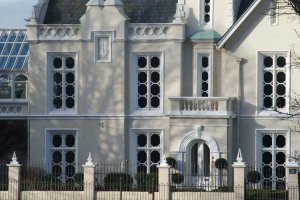Project 9 relates to the use of focal length to frame a photo and draw attention to a particular subject or element within a scene. For this exercise I took my wide angle lens and telephoto lens to a local landmark called the Castle Pool, and took a range of photos at different focal lengths. The sequence below shows how increasing focal length changes both the image composition and the subject, as the same scene goes from being a wide angle view of the pond with the hotel a less conspicuous background object, to a close-up telephoto view focusing on the Georgian architecture.
18mm focal length shows the whole scene with the hotel a very small part of it. This works well in terms of setting the scene, although the trees dominate the shot to a certain extent which I feel detracts from it a little, as clearly they are not the most interesting part.
At 35mm we have what is probably my favourite from the sequence. The trees are less intrusive, the ducks are larger and more interesting as a result, and the hotel is much more prominent with details of its architecture visible enough to draw attention. This is the version I used to create the HDR image shown below.
The 50mm focal length photo brings the hotel even more into the shot, and while I feel this is a good focal length to show the hotel and its surroundings, the ducks are now almost out of shot and are really nothing more than a distraction.
At 70mm the hotel is now clearly the focal point of the shot, with the frozen pond providing a little bit of foreground interest, and the trees framing the image nicely without being intrusive.
Moving on to 100mm, and the hotel now dominates the shot. The trees and frozen pond are banished to the edges of the composition, and serve only to frame the main subject. The railings of the fence between the hotel and the pond are visible, as are architectural details around the windows and door.
135mm focal length next, and the ducks are a distant memory. The tiles on the roof are now visible and the hotel is tightly framed within the composition.
Next up is 200mm focal length, and we have now lost the pond and some parts of the building. The tops of the chimneys are outside of the frame, as is part of the conservatory.
Finally we are at 300mm and a close-up of the hotel. All the architectural details are visible, including the year the original hotel was built, 1823. Bushes in the garden can be seen, as can details on the wall and fence.
From this exercise I have learned how focal length can draw attention to different elements of a scene by changing the composition and framing of a shot. My personal favourite was the 35mm, although if you were aiming to portray the hotel as the main subject of the image, then the 100mm or 135mm also do the job quite nicely.










